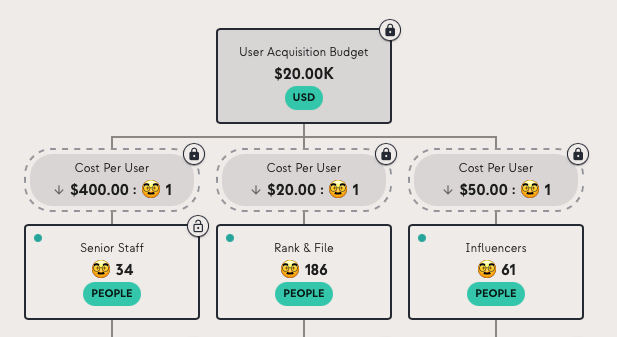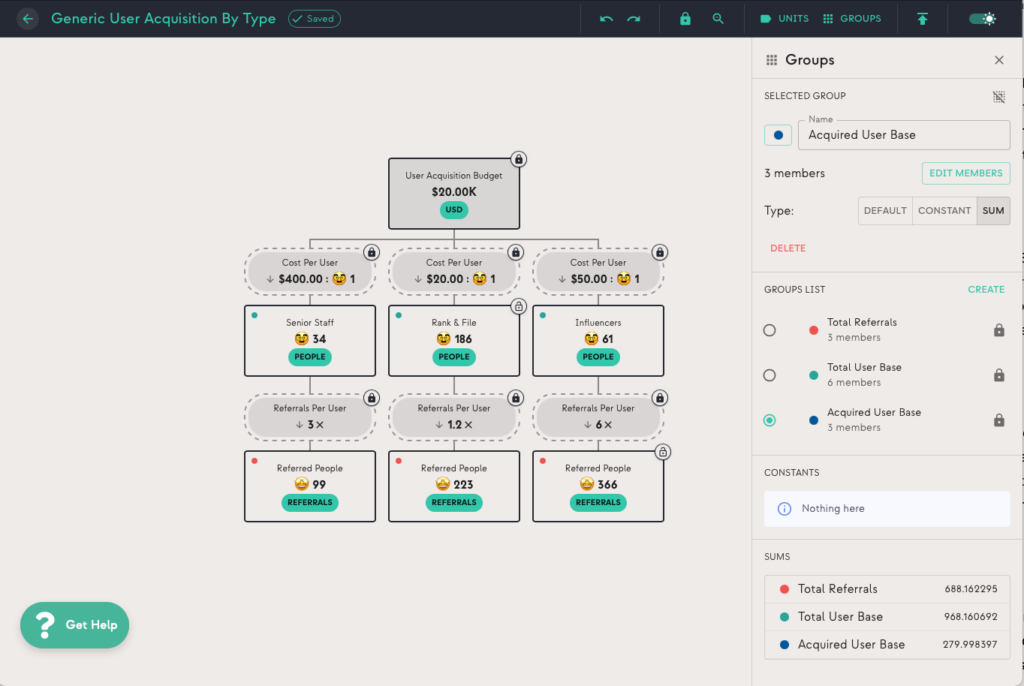
I’ve spent a lot of time trying to get Resolution to represent the most complicated scenarios it possibly can. Compared to the average user, I’m (unsurprisingly) pretty good at doing this, even if some of the results are kind of ridiculous.
However, in doing so, I’ve learned that some of the biggest “aha!” moments in the application aren’t with complex models. They are with really, really simple ones, like the one I built today.
Considering User Types
Here’s the situation. I’m helping someone figure out yet another go-to-market plan (hopefully better than Resolution’s), and one of the things we’re budgeting for (unlike Resolution) is some money to acquire users. At first, I just threw all these different people in a big “user” bucket, and assigned a single set of costs and benefits to that big bucket.
However, this turns out to be more than a bit too simple. We have powerful, important, advocate-like users with much higher acquisition costs and network effects than normal users, or especially casual users (like students). I really need to consider what the user breakdown by type is going to be — not just to anticipate my costs, but to understand my downstream network effects. Unfortunately, I’m working in a spreadsheet, so there are a lot of annoying things about trying to take this stuff into consideration.
Brittle Formulas
Again, I’m in a spreadsheet. For every additional factor I want to consider, I either need to manually code it into my formulas (and have to update it umpteen times if it changes), or find a place I can stash it, and then reference that value. Either way, if I suddenly change the way I’m doing this (by, say, referencing one of several potential values in each place instead of using the same one all the time), I have a lot of refactoring to do, which usually leads to me making mistakes.
Unclear Inputs
The driver of my user acquisition numbers is my user acquisition budget. But of course, we’re not totally set on what that should be yet. In fact, as is often the case, the answer is really “as low as possible”, but we don’t know what that is yet. So I can’t just say “the budget is $20k”, nor can I say “the budget is whatever it takes to get 100 power users and 400 casuals”. I have to give and take on both sides of that to come up with something that makes sense.
Rates Up For Grabs
This is one of those classic Resolution-y scenarios where no answer is ridiculous until you see it, at which point it’s obviously ridiculous and you want to make sure you never see it again. What’s a reasonable acquisition cost for a power user? A hundred dollars? “That’s nothing!” A thousand dollars? “THAT’S INSANE!!!” Okay, okay. I need to be able to take these different costs on and off the table, and probably put some floors and ceilings on them.
What a Flex
Basically, I have what seems like a really simple math problem, except I want a whole bunch of different things to be able to flex — and of course, I want to be able to go “backwards”, where I can use money to determine user outputs, OR I can request certain amounts of certain types of users at certain costs and see that affect the required “input”.
Aaaaaand…. here it is.

To be honest, this was even simpler when I started. I simply had my pile of money, my three user groups, and my three costs. All I really wanted to do was figure out what reasonable acquisition costs would be for the goals we have, but once I had that established I immediately wanted to plug in some of the downstream effects, so I just… added them.
Where the model really shines, though, is when the questions come (and they always do):
- Can you make this work with 15k? How does that affect the total user base?
- What if we spent a lot more money on influencers and a lot less on the rank and file users?
- What if referrals are actually stronger from senior staff than from influencers?
- What’s the cheapest way to get me to 500 users?
- Follow-up: “Okay, not that way, what else can you do?”
I built this model in 5 minutes. It’s not complicated. But I poked at it and tried different scenarios for the next 20, and I’ve come back to it several times since. Scenarios! Flexibility! It’s all there, baby!

